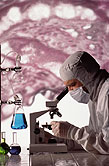
MONDAY, March 30, 2015 (HealthDay News) — America is making slow but steady progress against cancer, with a continuing decline in cancer deaths, according to a new report.
The overall cancer death rate fell an average 1.5 percent per year between 2002 and 2011, representing improved survival for men, women and children, the report found.
The rate of new cancer cases also declined an average 0.5 percent a year during that period.
Experts say the promising figures reflect success in both treating and heading off cancer in the body’s four most vulnerable sites — the lungs, colon, breasts and prostate.
“These numbers reflect a combination of factors that include prevention, early detection and improved treatment,” said report co-author Ahmedin Jemal, vice president of surveillance research for the American Cancer Society.
However, the new report also found that cancer rates are rising for some rarer forms of cancer, including cancer of the liver, mouth and throat, thyroid, and kidneys.
The annual report was published in the March 30 issue of the Journal of the National Cancer Institute. The report was co-authored by experts from the North American Association of Central Cancer Registries, the American Cancer Society, the U.S. Centers for Disease Control and Prevention, and the U.S. National Cancer Institute.
Combining resources, the four groups concluded that cancer deaths fell 1.8 percent a year among men between 2002 and 2011, 1.4 percent a year for women and just over 2 percent a year for children.
New cancer cases fell slightly for men during that decade, while remaining level for women, according to the report. The incidence rate for new cancers in children 19 and younger increased, but by less than 1 percent a year, the report stated.
Those two trends indicate that cancer is being effectively prevented and, if it occurs, successfully treated, said Recinda Sherman, report co-author and program manager of data use and research for the North American Association of Central Cancer Registries.
Advances in lung cancer are tied directly to fewer people smoking, while the decline in colon and breast cancers also are tied to prevention efforts, Sherman said.
For example, colon cancer is preventable through screening, with doctors able to detect and remove dangerous pre-cancerous polyps through a colonoscopy.
“The early polyps are being removed even before they turn into cancer,” said Dr. Lynne Penberthy, senior author of the annual report and associate director of the Surveillance Research Program at the U.S. National Cancer Institute.
Prostate cancer rates also are declining, but experts are not exactly sure why that is occurring. Prostate cancer screening is no longer recommended, Jemal said, which could lead to a decline in detected new cases.
Rarer cancers are on the rise for various reasons. Liver cancer, for instance, has increased due to long-lasting hepatitis C infections that occurred in drug-using baby boomers in the 1970s and early 1980s, Sherman said.
Penberthy agreed, adding that obesity and alcohol abuse also have played a factor in rising liver cancer cases and deaths. “There are potential interventions that would reduce the risk of this cancer,” she said.
Mouth and throat cancers also have been increasing among men, even though they are considered a tobacco-related type of cancer, Sherman said.
This increase in cancer likely is due to human papillomavirus infection, or HPV, the sexually transmitted disease that also is the leading cause of cervical cancer in the United States, she said.
A vaccine has been developed for HPV and is currently recommended for both boys and girls. “These numbers show there’s definitely a reason to promote that vaccine for both genders,” Sherman said.
Other increases in rare cancers remain a mystery. For example, no one is sure exactly why thyroid and kidney cancers are rising among men and women, Sherman said.
People who want to avoid cancer should avoid tobacco use and exposure to secondhand smoke, take steps to protect themselves from the sun’s ultraviolet rays, eat a healthy diet rich in fruits and vegetables, take in lots of physical activity, and maintain a healthy weight, said Blythe Ryerson, a report co-author and epidemiologist for the U.S. Centers for Disease Control and Prevention.
But one of the best cancer-prevention techniques is fairly simple — just make it to your annual check-up with your doctor, experts say.
During your check-up, the doctor will make sure you get the cancer screenings that are appropriate to your age and gender, and also see whether you need vaccinations that can prevent cancer, Ryerson said.
More information
For more about cancer, visit the U.S. National Library of Medicine.
Copyright © 2025 HealthDay. All rights reserved.

